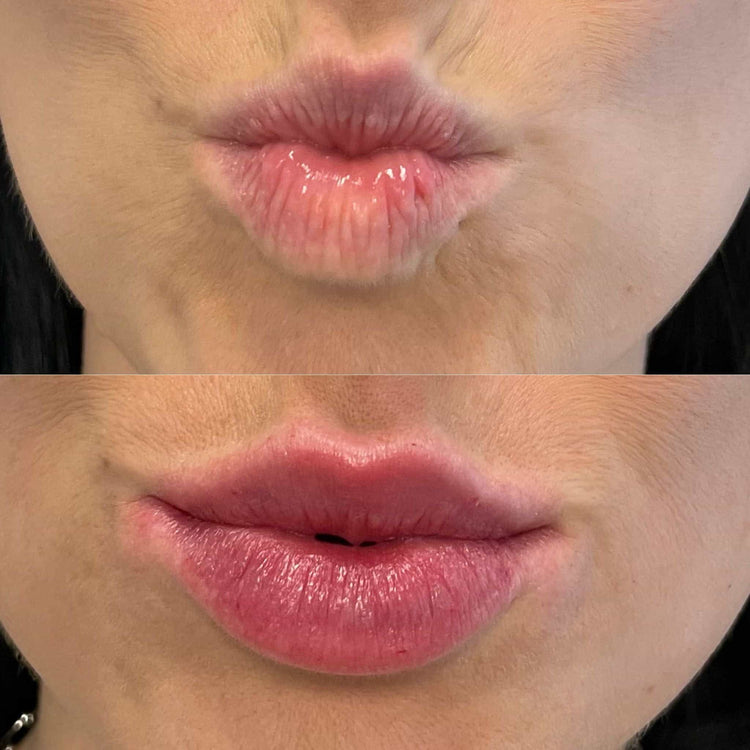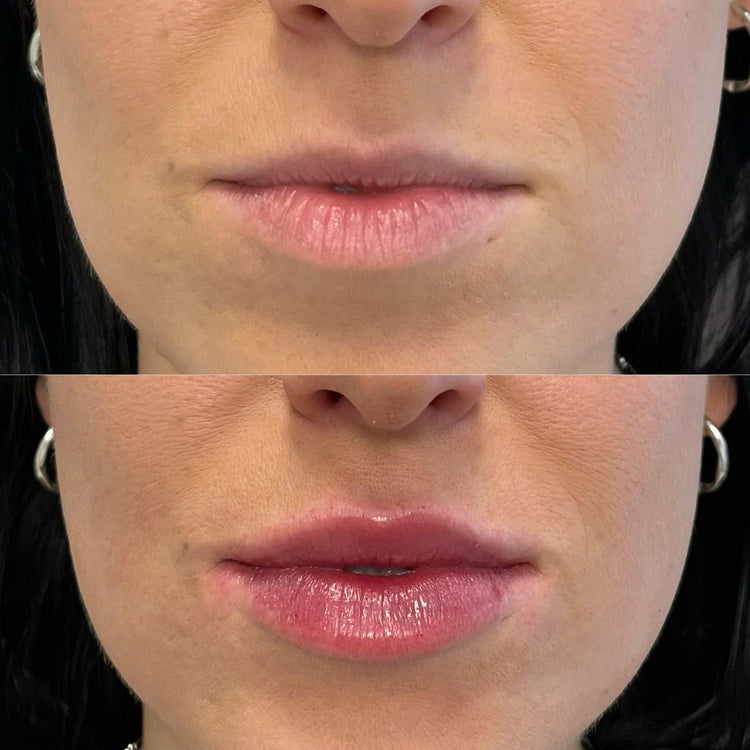What Is The Difference Between Dermal Fillers And Lip Fillers?
Dermal Fillers
Dermal fillers have become increasingly popular for their ability to smooth wrinkles, restore volume, and enhance facial features. These injectable substances are designed to be placed beneath the skin’s surface, adding fullness and plumpness to targeted areas.

What are Dermal Fillers?
Dermal fillers are a type of cosmetic treatment that uses gel-like substances to add volume or smooth wrinkles in the face. They work by injecting a substance that is similar to hyaluronic acid, which is naturally found in the body and helps to keep skin plump and hydrated.
How Do Dermal Fillers Work?
Dermal fillers contain hyaluronic acid, a natural substance found in the skin that attracts and holds water. When injected, these fillers add volume to areas where it has been lost due to aging, creating a smoother, more youthful appearance.
The gel-like consistency of dermal fillers allows them to be molded under the skin, filling in wrinkles and folds while supporting facial contours. This plumping effect helps reduce the appearance of fine lines, deep creases, and hollows beneath the eyes or cheeks.
Types of Dermal Fillers
Dermal fillers encompass a range of injectable substances used for various cosmetic purposes, including smoothing wrinkles, restoring volume, and enhancing facial features. Lip fillers, as the name suggests, are a specific type of dermal filler primarily focused on augmenting the lips.
While lip fillers fall under the broader category of dermal fillers, they are formulated with particular properties suited for the delicate and sensitive tissues of the lips.
Types of dermal fillers include hyaluronic acid-based fillers, collagen-based fillers, poly-L-lactic acid (PLLA) fillers, and calcium hydroxylapatite fillers.
Hyaluronic acid is a naturally occurring substance in the body that attracts and retains moisture, providing volume and hydration to the skin.
Collagen is a protein that gives skin its structure and elasticity. Collagen-based fillers can help restore lost volume and improve skin texture.
PLLA fillers stimulate collagen production in the body, leading to gradual volumization over time. Calcium hydroxylapatite fillers are composed of microspheres of calcium hydroxylapatite, which provide immediate volume and support facial contours.

Areas Treated by Dermal Fillers
Dermal fillers are used to smooth wrinkles, restore volume, and enhance facial features by injecting gel-like substances beneath the skin’s surface.
These injectables can be used to treat various areas of the face, including the cheeks, forehead, temples, laugh lines (nasolabial folds), marionette lines (lines from the corners of the mouth to the chin), lips, and under-eye hollows.
The choice of filler type depends on the desired outcome and the specific area being treated.
Lip Fillers
Lip fillers are a specialized form of dermal filler designed specifically for enhancing the appearance of the lips. Unlike some other dermal fillers, lip fillers are formulated with particular properties to suit the delicate tissues of the lips, ensuring both safety and effective results.
What are Lip Fillers?
Lip fillers are a type of cosmetic injection used to enhance the size, shape, and fullness of the lips. They are made from hyaluronic acid, a naturally occurring substance in the body that attracts and holds water.
When injected into the lips, hyaluronic acid fillers add volume and plumpness, creating a fuller and more defined appearance. Lip fillers can be used to address various concerns, such as thin lips, asymmetry, or loss of lip definition due to aging.
The results of lip fillers are typically visible immediately after treatment and can last for several months to a year, depending on the type of filler used and individual factors.
How Do Lip Fillers Work?
Lip fillers work by injecting hyaluronic acid into the lips. Hyaluronic acid is a naturally occurring substance in the body that attracts and holds water, giving the skin volume and plumpness.
When injected, lip fillers add volume to the lips, making them appear fuller and more defined. They can also be used to correct asymmetry or restore lost definition due to aging.
Types of Lip Fillers
Lip fillers are a specialized type of dermal filler specifically designed for enhancing the lips. Unlike some other dermal fillers, lip fillers are formulated with particular properties suited to the delicate tissues of the lips, ensuring both safety and effective results.
They aim to augment the size, shape, and fullness of the lips by injecting hyaluronic acid, a naturally occurring substance in the body that attracts and holds water.
Lip fillers are commonly used to address concerns such as thin lips, asymmetry, or loss of lip definition caused by aging.
The effects of lip fillers are typically noticeable immediately after the procedure and can last for several months to a year, depending on the type of filler used and individual factors.
Lip fillers work by injecting hyaluronic acid into the lips. This substance attracts and holds water, adding volume and plumpness to the lips, resulting in a fuller and more defined appearance.
Benefits of Lip Fillers
Lip fillers provide several benefits for those seeking to enhance their lip appearance. They can add volume to thin lips, creating a fuller and more youthful look.
Lip fillers can also be used to correct asymmetry in the lips, resulting in a more balanced and harmonious appearance.
For individuals who have experienced loss of definition in their lips due to aging, lip fillers can help restore volume and plumpness, making them appear more defined.
By injecting hyaluronic acid, a naturally occurring substance that attracts and retains water, lip fillers effectively increase the fullness and hydration of the lips.
Differences Between Dermal Fillers and Lip Fillers
Dermal fillers encompass a range of injectable substances used for various cosmetic purposes, including smoothing wrinkles, restoring volume, and enhancing facial features. Lip fillers, as the name suggests, are a specific type of dermal filler primarily focused on augmenting the lips. While both fall under the umbrella of dermal fillers, lip fillers possess unique formulations tailored to the delicate tissues of the lips.
Composition and Formulation
Dermal fillers and lip fillers both belong to the family of cosmetic injectables designed to enhance appearance. However, they have distinct applications and formulations.
- Dermal fillers: These are versatile injectable substances used for a wide range of aesthetic purposes. They target areas like wrinkles, folds, hollows beneath the eyes or cheeks, and can even augment cheekbones or jawlines.
- Lip fillers: As their name suggests, these are specifically designed for enhancing the lips. Their formulations prioritize the unique needs of delicate lip tissue.
Composition is another key difference. Dermal fillers encompass a variety of ingredients, including hyaluronic acid (HA), collagen, poly-L-lactic acid (PLLA), and calcium hydroxylapatite.
- Hyaluronic acid is the most common ingredient in both dermal and lip fillers. Its ability to attract and retain water gives skin volume and hydration.
- Collagen-based fillers provide structure and elasticity, while PLLA stimulates collagen production for gradual volumization over time.
- Calcium hydroxylapatite provides immediate volume and support.
Lip fillers typically prioritize hyaluronic acid due to its safety profile and effectiveness in lip augmentation. The formulation may also include additional ingredients to enhance texture, smoothness, or longevity.
Purpose and Application
Dermal fillers are a broad category of injectables used for various cosmetic purposes, such as smoothing wrinkles, restoring volume, and enhancing facial features. Lip fillers, on the other hand, are a specialized type of dermal filler specifically designed for augmenting the lips.
While both types utilize hyaluronic acid, lip fillers often contain additional ingredients tailored to the delicate tissues of the lips, ensuring both safety and effective results. Dermal fillers encompass a wider range of substances, including collagen, poly-L-lactic acid (PLLA), and calcium hydroxylapatite, each offering different benefits depending on the desired outcome and targeted area.
Lip fillers primarily focus on enhancing lip size, shape, and fullness, addressing concerns like thin lips, asymmetry, or loss of definition due to aging. Dermal fillers, being more versatile, can be used for a wider range of treatments, targeting areas like wrinkles, folds, hollows, and even cheekbones or jawlines.
Treatment Areas
Dermal fillers encompass a wide array of injectable substances designed for various cosmetic purposes, including smoothing wrinkles, restoring volume, and enhancing facial features. Lip fillers, as their name suggests, are a specialized type of dermal filler focused primarily on augmenting the lips.
While both fall under the broader category of dermal fillers, lip fillers have unique formulations tailored to the delicate tissues of the lips, ensuring both safety and effective results.
Dermal fillers can be used to address various areas of facial concern, including wrinkles, folds, hollows beneath the eyes or cheeks, and can even augment cheekbones or jawlines.
Lip fillers, on the other hand, primarily focus on enhancing lip size, shape, and fullness. They are commonly used to address concerns such as thin lips, asymmetry, or loss of definition due to aging.
The choice between dermal fillers and lip fillers depends on individual needs and desired outcomes.
Duration of Results
Dermal fillers and lip fillers both involve injecting substances beneath the skin’s surface to enhance appearance, but they have distinct focuses and applications. Dermal fillers encompass a broader range of injectable substances used for various cosmetic purposes, such as smoothing wrinkles, restoring volume, and enhancing facial features. Lip fillers, as their name suggests, are specifically designed for augmenting the lips.
While both types often utilize hyaluronic acid, lip fillers may contain additional ingredients tailored to the delicate tissues of the lips, ensuring both safety and effective results.
The duration of results for dermal fillers and lip fillers can vary depending on factors such as the type of filler used, individual metabolism, and lifestyle choices. Generally, hyaluronic acid-based fillers tend to last between six months to a year before needing repeat treatments. Other types of fillers, like PLLA, may provide longer-lasting results.
Discover the lip filler process with Dr. Laura Geige at It’s Me & You Clinic
- How Dermal Fillers Can Improve The Appearance Of Scars - August 6, 2025
- How Bodystockings Enhance Bedroom Play - August 5, 2025
- Heteroflexibility And Exploring Attraction Beyond Labels - August 4, 2025
